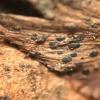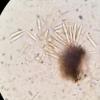
09-11-2025 13:20
Hello.A tiny ascomycete, appearing as erupting gra

08-11-2025 00:29
 Francois Guay
Francois Guay
I found this species in Quebec, Canada, on herbace

04-11-2025 09:07
Hello.A suspected Hymenoscyphus sprouting on a thi

04-11-2025 12:43
 Edvin Johannesen
Edvin Johannesen
Hi! One more found on old Populus tremula log in O

03-11-2025 21:34
 Edvin Johannesen
Edvin Johannesen
These tiny (0.4-0.5 mm diam.), whitish, short-stip
On Pseudotsuga cones, Discosia pini ? - Discosia strobilina ?
Ethan Crenson,
23-03-2021 06:34
Hello all,
I found these black pycnidia of an imperfect asco growing on a cone of Pseudotsuga menziesii in a cemetery/arboretum in Brooklyn, New York, US. I believe these belong to the genus Discosia, but I'm uncertain of the species.
The pycnidia are black, lightly striate, elliptical, flat, sometimes with a pore or ostiole developing in the center. They are smaller than 1mm in length.
The conidia are hyaline, fusiform, 3-septate, usually with 2 long setulae emerging from one side of the conidiospore near the outer septa. Many of the conidia I observed had deformed outer cells as though those cells were deflated or malformed. I'm not sure if that is an important feature or if it's an anomoly caused by environmental factors. Conidia size: (14.5) 18-20 x 3µm, the setulae range from 5-14µm in length. The conidia were almost uniformly 3µm wide, without any variation.
Because of the substrate, two possibilities may be Discosia pini and Discosia strobilinia. But I don't have any experience with this genus, so hopefully someone can help.
Many thanks in advance,
Ethan
Bernard Declercq,
23-03-2021 15:00

Re : On Pseudotsuga cones, Discosia pini ? - Discosia strobilina ?
Hi Ethan,
Compare with D. strobilina which has conidia with the lower middle cell longer than the upper one. D. pini has middle cells of about the same length.
Bernard
Compare with D. strobilina which has conidia with the lower middle cell longer than the upper one. D. pini has middle cells of about the same length.
Bernard
Ethan Crenson,
23-03-2021 15:27
Re : On Pseudotsuga cones, Discosia pini ? - Discosia strobilina ?
Thank you Bernard! D. strobilina--I think you're right. At a glance the middle cells are quite different in length. Is the deformation of the outer cells anything to consider, or just an anomoly? (I have seen it happen to Bertia moriformis spores as well.) And is there a recent paper I can find about Discosia?
Ethan



